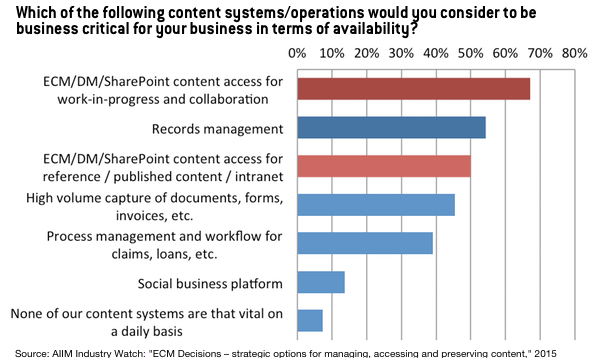
Not so many years ago, when you asked about enterprise content management (ECM), it was common to hear the words, “ECM is nice, but I do not consider it to be mission critical like my finance or customer relationship management (CRM) systems.” Today, this response is changing.
According to the latest AIIM report, titled “ECM Decisions – strategic options for managing, accessing and preserving content,” for 67% of organizations, ECM/document management (DM) is now considered mission critical. Fifty-four percent of respondents see records management (RM) as mission critical, and 40% cite capture and workflow as being mission critical for their organizations. When considering the impact loss of access would have, a third indicate they would suffer serious disruption after an outage of just one hour, while 58% say they would struggle after half-a-day of downtime.

Consider this
The bulk of today’s content is either born digital using office applications, email and social media or converted to digital form through the use of scanners, digital cameras and mobile devices. The information captured ranges from text and graphics to audio and video. The amount of content captured grows exponentially with each passing day, requiring businesses to find better ways to manage it in order to avoid a state of information chaos. It is not uncommon for businesses to have more than one ECM/DM system in place and also maintain file shares, as only one percent o f those polled indicate their file shares have been shut down.
What to think about
Given that ECM is now seen as “mission critical” for the majority of businesses, it is essential that serious consideration be given to the multi-dimensional elements of an ECM environment. This includes people, process, governance, technology and continuous improvement initiatives to further enhance ECM. Look at the processes, people and content used as part of the process. Understand how these are interrelated, and assess whether your current ECM systems are truly aligned to support them. If they are limited in some of the core functional areas or require massive customization, consider consolidating around a new, better-suited system.
Review your information governance (IG) policies and identify areas for improvement. For example, is mobile and cloud use addressed? If not, begin taking steps to add this to your IG framework and spell out what is considered appropriate use, devices supported and security measures related to them.
Automate where possible to extend technology use in streamlining operational processes, establishing higher levels of accuracy and consistency and minimizing risk. For example, capture of content should be done at first touchpoint, bringing it under corporate control early in the process. Automating the capture process using recognition technologies to properly categorize, store content and initiate workflows can mean the difference between days and minutes for action to be taken.
In my view
In my view, the recognition of ECM as mission critical by businesses strengthens the need for greater focus in the planning stages of an ECM project. Where once the technology was distributed throughout the organization with visions of user acceptance, it is now embedded as a vital part of the core information ecosystem. Successful implementation extends beyond installation of hardware and software to usability, acceptance and tighter integration with line-of-business applications. Where once a business could function without ECM, the majority now indicate it would impair business operations in the same way outages of a finance and point-of-sale system would.
The story of ECM goes beyond implementation and must be maintained as a vital entity. Along with maintenance, there is a need for disaster preparedness and recovery should chaos strike. As time passes, digital preservation is required to ensure vital information is accessible in the future. Format, media and software must be periodically reviewed and updated. In some cases, migration may be required due to obsolescence. This should be part of a continuous improvement program to enhance and manage the ECM environment for the long term.
Bob Larrivee is director of custom research at AIIM and an internationally recognized subject matter expert and thought leader with over 30 years of experience in the fields of information and process management. He is an avid techie with a focus on process improvement and the application of advanced technologies to enhance and automate business operations. Follow him on Twitter @BobLarrivee.
















